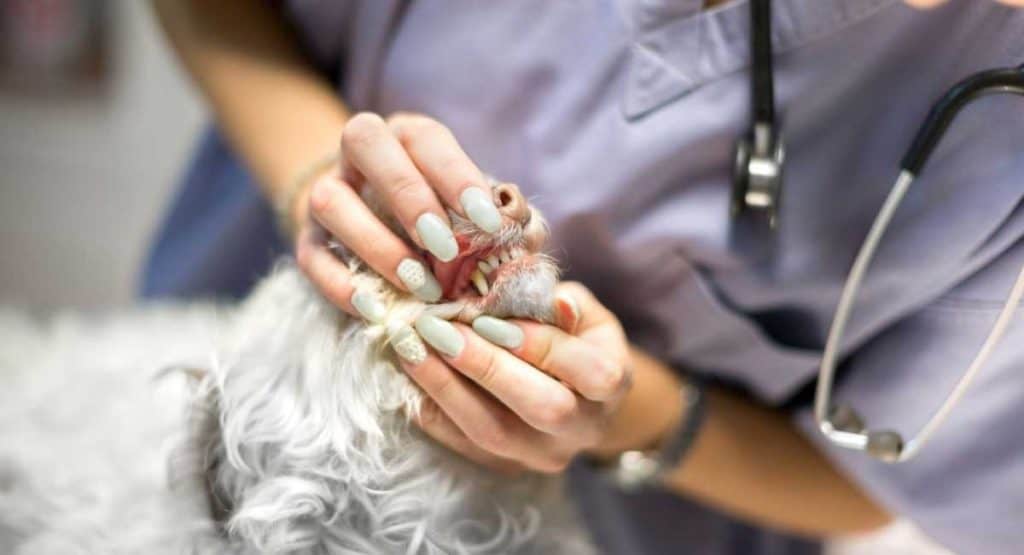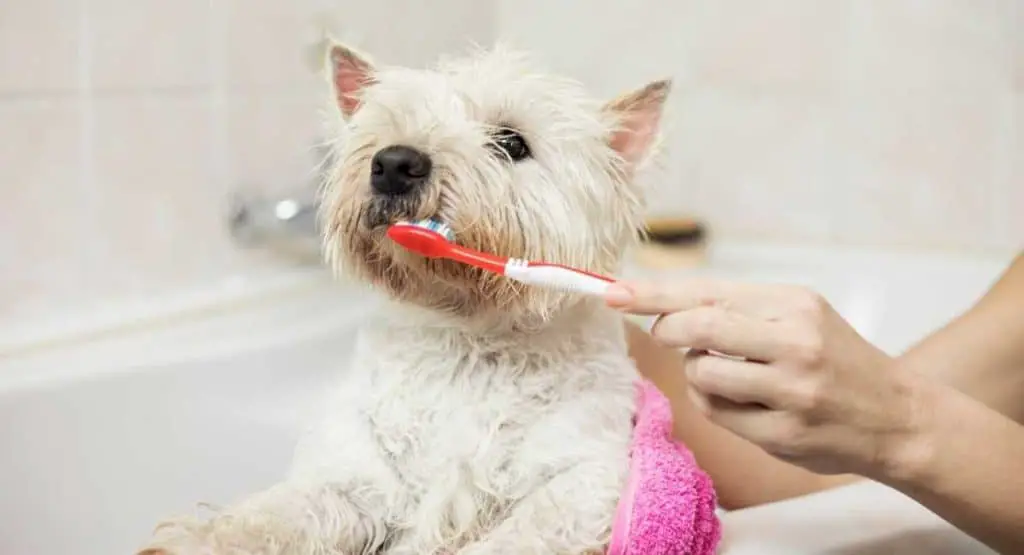Braces for dogs might sound silly, but if your dog suffers from certain dental issues, it might be the best option. Unlike human braces, braces for dogs are not done for aesthetic reasons, but for health reasons. Braces can help dogs with a variety of issues, from deformed teeth to the aftereffects of cancer.
Braces for dog’s hips, legs, or knees may also be needed to insure that your pup can live as comfortably as they did when they were young. Some breeds can have hip or leg issues develop earlier in life, and a brace can help these dogs live relatively pain free.
Disclaimer: The Can My Dog articles contain information based on the individual research and opinions of the author of the site – who just so happens to be a dog. How you utilize the information given is completely up to you. Proceed at your own risk.
Health Problems That Lead to Dog Braces

Linguoversion
Linguoversion is one of the main reasons why dogs need braces. It’s when a dog’s teeth get pushed back, and instead of facing upwards as normal, they face back into the dog’s mouth and tongue. When this happens to a dog’s lower teeth, it can actually cause teeth to poke holes in the top of the dog’s mouth.
When that happens, it can cause severe and chronic health issues such as sinus infections. Treating these issues will usually cost more in both time and money than treating the original dental problems caused by linguoversion.
Overbite
As with humans, occasionally a dog will suffer from an overbite, where the bottom jaw is not the same size as the top. This can cause discomfort for your dog that will stop them from eating. Dog braces can help realign the teeth in a manner that will lessen, or even eliminate, the discomfort, giving your dog a healthy life.
Lance Teeth
Lance teeth is a condition where the canine teeth stick outwards instead of pointing down. This commonly results in tooth-to-tooth contact, which can cause serious discomfort, especially when eating or otherwise using their mouth. Braces can be used to build space between the teeth, eliminating this discomfort.
Remaining Baby Teeth
Sometimes a dog’s baby teeth don’t fall out as they should. If this happens, when the dog’s permanent teeth grow in, their mouth becomes overcrowded, which can lead to discomfort and increase the risk of infection. Braces can space out the teeth better to lessen this risk, and the discomfort.
Cancer
In some cases, braces may be used after part of a dog’s jaw has been removed due to cancer. This prevents tooth drift, which can cause added pain and discomfort for your dog. If your dog needs to have part of its jaw removed, be sure to ask if braces will be needed afterwards to prevent this tooth drift.
How to Determine If Your Dog Needs Braces
Most of the time, the diagnoses for if your dog needs braces occurs when the dog is fairly young. Problems can typically be spotted by your vet when the dog’s permanent teeth begin to come in, around four to six months of age.
Some puppies won’t show any sign of mouth discomfort, so it’s important to take them to the vet when young so any problems can be discovered as soon as possible.
To guarantee your dog is healthy enough for anesthesia, a veterinary dentist will conduct a full examination of your pet, not just of their mouth. Multiple rounds of surgery may be needed, depending on what orthodontic procedures need to be undertaken, so your dog must be up for it.
While the orthodontic appliances used may differ, one thing that doesn’t is that it’s up to the owner to maintain and clean their dog’s mouth and the brace throughout the treatment process.
Caring for Your Dog Through the Process
During the treatment of their dog’s mouth, owners will need to clean and brush the dog braces and clean the dog’s mouth with oral antiseptic on a daily basis. Some dogs may need their diet changed to soft foods or wet food during the duration of the treatment. Any toys and bones should be avoided while your dog has its brace.

Luckily, moving dog teeth is a relatively quick process. Depending on the condition of their mouth, most dogs only wear their doggie braces for a few weeks or a few months. Also, once the dog’s teeth are corrected, there is no need for any sort of retainer. The fix is typically a permanent one.
Alternatives
Depending on your dog’s condition, there are several alternatives to orthodontic appliances like dog braces. Consult with your vet on if these can replace a brace for your dog.
“Rubber Ball Therapy”
In certain, less severe cases, moving your dog’s teeth can be accomplished by positioning a lacrosse ball in your dog’s mouth. Taught how to be done correctly, this procedure uses the pressure of your dog’s bite to realign the teeth. While the cheapest option, this requires a patient owner and easygoing dog.
Dental Extractions
The filing down or extraction of problem teeth may be another option in place of dog braces. While cheaper than braces, these procedures have their downside. Filing the teeth requires yearly checkups, and possible future adjustments. Dental extraction can be a complicated and painful oral surgery, and extraction doesn’t guarantee braces won’t be needed in the future.
Leg Braces
Like humans, dogs may sometimes need braces for hip, leg, or knee problems. As dogs age, they can be more prone to injury or disease that affects their mobility, and a brace may just be what they need to improve their quality of life.
Knee Braces
A dog knee brace is designed to provide support and stability for canine ACL tears. Tears to a dog’s CCL (Cranial Cruciate Ligament) are one of the most common orthopedic injuries veterinarians deal with.
As with a human, a tear in the CCL can cause pain and immobility. Orthopedic braces can be designed specifically to ease this problem in your dog, and come in many brands and price points.
Hip Braces
Certain dog breeds are more prone to hip issues such as hip dysplasia or other joint problems. Dog braces for the hip are typically made of high-quality spacer mesh material and webbing, allowing them to be adjusted for nearly any dog in any environment. A brace for your dog’s hip problems can help restore pain-free activity and mobility to aging or injury-prone dogs.
Wrist/Ankle Braces
Known as a carpus brace in dogs, a wrist brace is another type of dog brace that can help your furry friend enjoy a better life. Age and weight can tend to cause laxity in the ligaments of your dog’s “wrist” leading to a host of medical problems. If you notice your dog limping a lot, a carpus brace may be exactly what you need to return comfort and ease of mobility to your furry friend.
If your dog is limping, or seems not to be able to get around as well as they used to, you should see your vet to determine if your dog needs one of these braces. With a variety of brands, designs, and costs, a brace can be found for nearly every dog and owner.
Conclusion
Your dog may need dog braces for both their teeth and/or legs due to a number of medical issues. Both orthodontic and orthopedic braces come in a variety of brands, styles, and prices. If your dog is having trouble with dental or leg/hip issues, be sure to make an appointment with your veterinarian in order to determine the best solution for both you and your pet.
It’s rough out there. Take care of each other!
Love you guys,
JTB
P.S. If you’re new to this world, you may want to check out my Ultimate Guide for First Time Dog Parents. It’s a great reference to get you started on this journey.
This article has been reviewed by our Editorial Board and has been approved for publication in accordance with our Editorial Policies.
